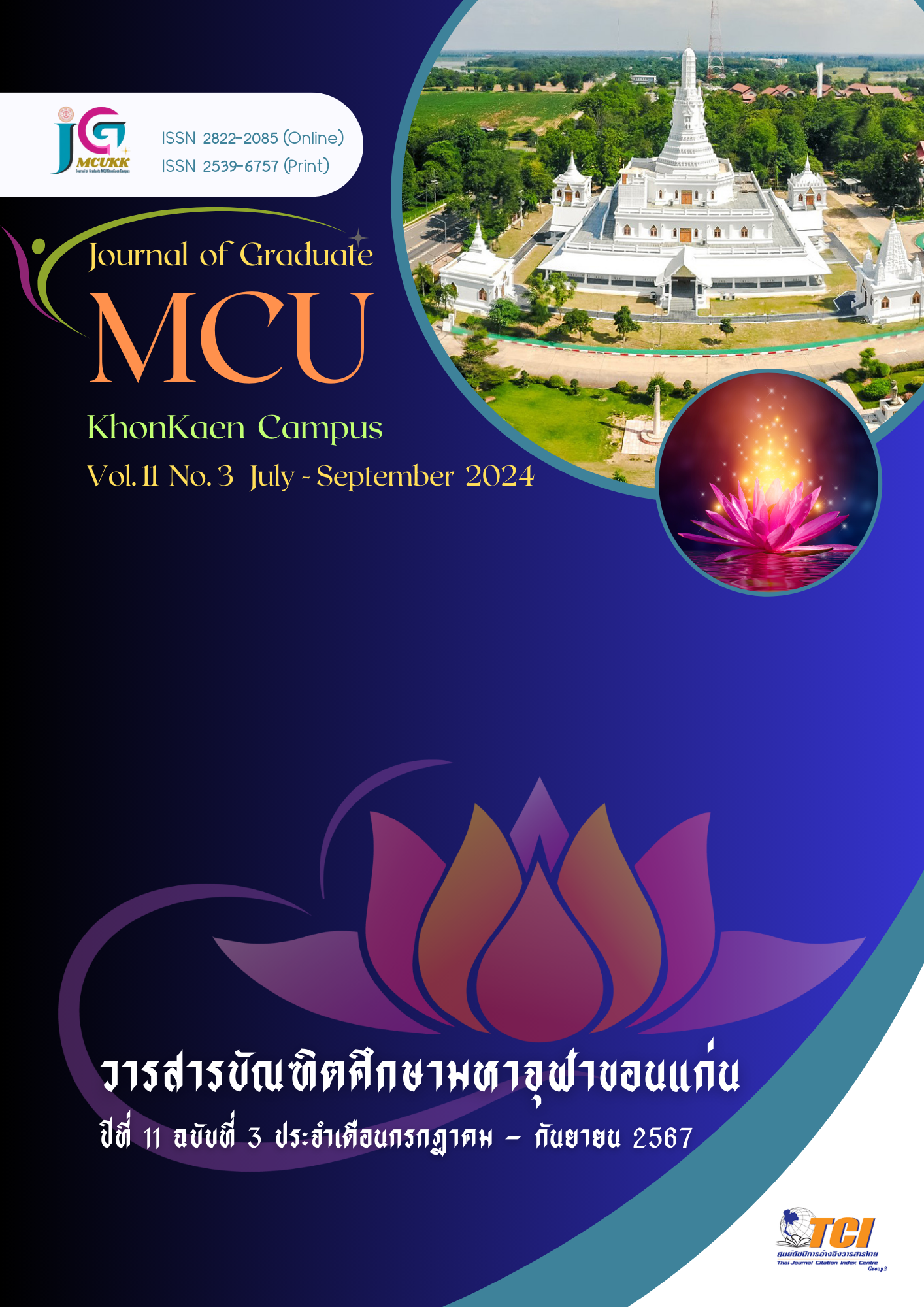การบริหารงานบุคคลตามหลักสังคหวัตถุ 4 ของผู้บริหารสถานศึกษา สังกัดสำนักงานเขตพื้นที่การศึกษาประถมศึกษาขอนแก่น เขต 1
Main Article Content
บทคัดย่อ
การวิจัยครั้งนี้มีวัตถุประสงค์เพื่อ 1) ศึกษาวิธีการบริหารงานบุคคลตามหลักสังคหวัตถุ 4 ของผู้บริหารสถานศึกษา สังกัดสำนักงานเขตพื้นที่การศึกษาประถมศึกษาขอนแก่น เขต 1 และ 2) เสนอแนวทางการบริหารงานบุคคลตามหลักสังคหวัตถุ 4 ของผู้บริหารสถานศึกษา สังกัดสำนักงานเขตพื้นที่การศึกษาประถมศึกษาขอนแก่น เขต 1 การวิจัยครั้งนี้เป็นการวิจัยแบบผสมวิธีระหว่างการวิจัยเชิงปริมาณและเชิงคุณภาพ การวิจัยเชิงปริมาณเครื่องมือที่ใช้ในการเก็บข้อมูลเป็นแบบสอบถาม ซึ่งมีค่าความเชื่อมั่นของแบบสอบถามทั้งฉบับเท่ากับ 0.98 กลุ่มตัวอย่าง ได้แก่ ผู้บริหารสถานศึกษาและครูผู้สอน จำนวน 305 คน สถิติที่ใช้ในการวิจัย ได้แก่ ค่าความถี่ ค่าร้อยละ ค่าเฉลี่ย ค่าส่วนเบี่ยงเบนมาตรฐาน การวิจัยเชิงคุณภาพเครื่องมือที่ใช้เก็บข้อมูลเป็นแบบสัมภาษณ์ โดยกลุ่มผู้ให้ข้อมูลสำคัญ ได้แก่ ผู้ทรงคุณวุฒิจำนวน 9 รูป/คนโดยการเลือกแบบเจาะจงเพื่อใช้สำหรับการตรวจสอบความสอดคล้องหรือเที่ยงตรง
ผลการวิจัยพบว่า
1. สภาพการบริหารงานบุคคลตามหลักสังคหวัตถุ 4 ของผู้บริหารสถานศึกษา สังกัดสำนักงานเขตพื้นที่การศึกษาประถมศึกษาขอนแก่น เขต 1 พบว่า ในภาพรวมและรายด้านมีการปฏิบัติอยู่ในระดับมากโดยด้านที่มีการปฏิบัติสูงสุด คือ ด้านสมานัตตตา รองลงมา คือ ด้านอัตถจริยา และด้านทาน และต่ำสุด คือ ด้านปิยวาจา
2. แนวทางการบริหารงานบุคคลตามหลักสังคหวัตถุ 4 คือ 1) ผู้บริหารสถานศึกษาควรมีความเอื้อเฟื้อเมตตาในด้านต่าง ๆ แก่บุคลากรอยู่เสมอ และส่งเสริมให้บุคลากรพัฒนาตนเองตามความเหมาะสม 2) ผู้บริหารควรสื่อสารกับบุคลากรในสถานศึกษาโดยใช้คำพูดที่ไพเราะ สุภาพอ่อนโยน มีน้ำเสียงนุ่มนวลเป็นกลางไม่เอนเอียง และให้เกียรติผู้ใต้บังคับบัญชาอยู่เสมอ 3) ผู้บริหารควรใช้ความรู้และดุลยพินิจในการสร้างระบบกลไกการสรรหา คัดเลือก มอบหมายงาน และประเมินการปฏิบัติงานของบุคลากรให้สอดคล้องกับความต้องการของสถานศึกษา 4) ผู้บริหารควรส่งเสริมให้ มีการจัดสวัสดิการแก่บุคลากรอย่างทั่วถึง มีการกระจายงานหรือหน้าที่รับผิดชอบให้บุคลากร และประเมินผลการปฏิบัติงานของบุคลากรด้วยความเป็นธรรมและเสมอภาค
Article Details

อนุญาตภายใต้เงื่อนไข Creative Commons Attribution-NonCommercial-NoDerivatives 4.0 International License.
เอกสารอ้างอิง
กฎกระทรวงกำหนดหลักเกณฑ์และวิธีการกระจายอำนาจการบริหารและการจัดการศึกษา พ.ศ. 2550. (2550, 16 พฤษภาคม). ราชกิจจานุเบกษา เล่ม 124 ตอนที่ 24 ก, หน้า 23-33.
กระทรวงศึกษาธิการ. (2556). คู่มือการบริหารโรงเรียนขั้นพื้นฐาน. (พิมพ์ครั้งที่ 2). กรุงเทพฯ: กระทรวงศึกษาธิการ.
พระครูประภัศร์ ธรรมาภิรักษ์ (จันเขียด). (2562). การบริหารสถานศึกษาตามหลักสังคหวัตถุ 4 ในสถานศึกษาขั้นพื้นฐาน สังกัดสำนักงานเขตพื้นที่การศึกษาประถมศึกษาชัยภูมิ เขต 1. (วิทยานิพนธ์พุทธศาสตรมหาบัณฑิต). พระนครศรีอยุธยา: มหาวิทยาลัยมหาจุฬาลงกรณราชวิทยาลัย.
พระธนพร คุณสมฺปนฺโน (อาคะนิช). (2565). การบริหารงานบุคคลตามหลักสังคหวัตถุ 4 ของผู้บริหารโรงเรียนพระปริยัติธรรม แผนกสามัญศึกษา เขต 7. (วิทยานิพนธ์ครุศาสตรมหาบัณฑิต). พระนครศรีอยุธยา: มหาวิทยาลัยมหาจุฬาลงกรณราชวิทยาลัย.
พระพรหมคุณาภรณ์ (ป.อ.ปยุตฺโต). (2551). พจนานุกรมพุทธศาสตร์ฉบับประมวลธรรม. กรุงเทพฯ: มหาจุฬาลงกรณราชวิทยาลัย.
พระสมุห์ประสาทพร มหาปุญโญ (รอดเสถียร). (2561). แนวทางการบริหารงานวิชาการตามหลักสังคหวัตถุ 4 ของโรงเรียนประถมศึกษา อำเภอพระประแดง จังหวัดสมุทรปราการ. (วิทยานิพนธ์พุทธศาสตรมหาบัณฑิต). พระนครศรีอยุธยา: มหาวิทยาลัยมหาจุฬาลงกรณราชวิทยาลัย.
พิธุวรรณ กิติคุณ. (2560). การปฏิรูปประเทศตามรัฐธรรมนูญแห่งราชอาณาจักรไทย พุทธศักราช 2560. กรุงเทพฯ: สำนักวิชาการ.
พุทธทาสภิกขุ. (2525). พุทธศาสนากับคนรุ่นใหม่และสังคมไทยในอนาคต. กรุงเทพฯ: สุขภาพใจ.
ลิษา สมัครพันธ์. (2562). การประยุกต์ใช้หลักสังคหวัตถุที่ส่งผลต่อการบริหารงานบุคคลของผู้บริหารสถานศึกษา สังกัดสำนักงานเขตพื้นที่การศึกษาประถมศึกษาจันทบุรี เขต 2. (วิทยานิพนธ์ครุศาสตรมหาบัณฑิต). จันทบุรี: มหาวิทยาลัยราชภัฏรำไพพรรณี.
Rita Pusvitasari. (2021). Human Resources Management in Improving the Quality of Education. Al-Tanzim: Jurnal Manajemen Pendidikan Islam, 5(02), 125-135.

